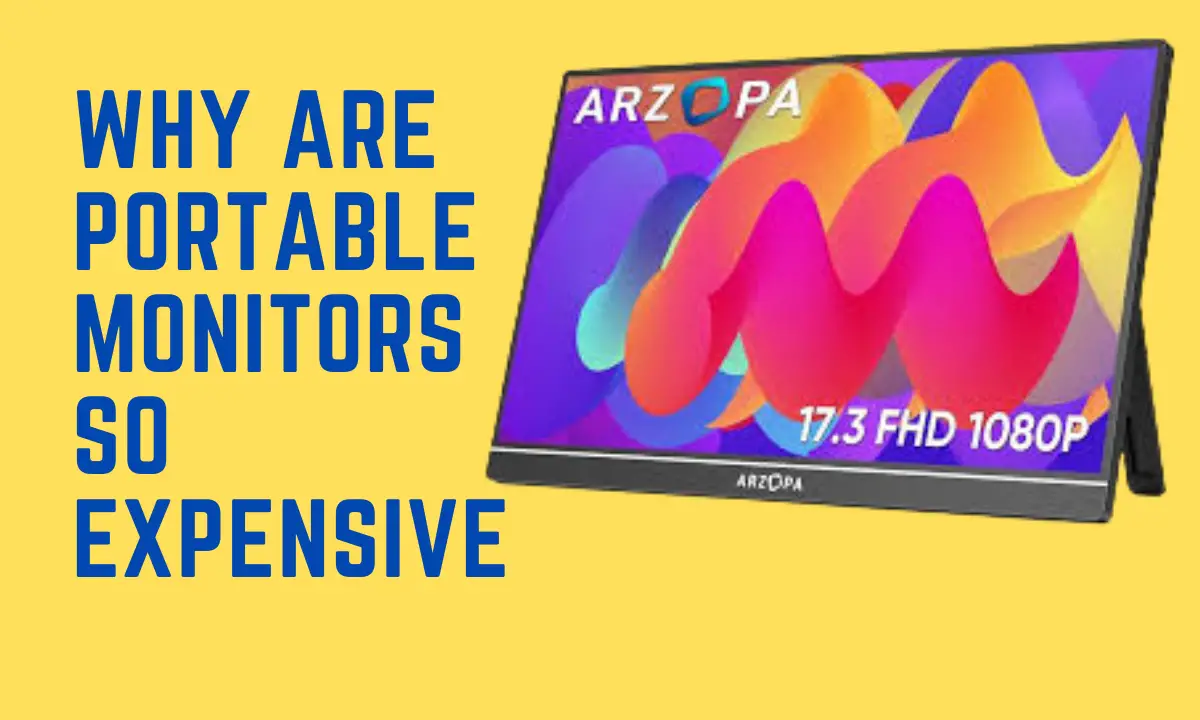Portable monitors seem to have taken the tech world by storm, offering the convenience of an extra screen for your laptop or a compact display for your game console. However, many consumers find themselves asking why these small, seemingly simple devices carry such a hefty price tag. In this article, we will explore why portable monitors are so expensive and whether they are worth buying. Let’s dive in!
Why Are Portable Monitors So Expensive
Portable monitors are often perceived as expensive due to a variety of factors, including their manufacturing costs, features, and market demand.
From a manufacturing perspective, portable monitors demand high-quality components to ensure durability, performance, and lightness, a necessity for portability.
It includes expensive elements like high-definition, low-energy consuming screens, lightweight but strong materials for the casing, and complex circuitry to provide plug-and-play functionality with various devices.
Moreover, portable monitors often come with advanced features such as touchscreen capabilities, high refresh rates, and compatibility with multiple operating systems.
The development and integration of these features require extensive research, innovation, and testing, which significantly escalates production costs.
Lastly, market demand and supply also play a crucial role in determining the price.
Portable monitors are a niche product, often targeted towards a specific audience, such as business travelers, gamers, and digital artists.
As the market for such specific users is relatively small, manufacturers tend to price these products higher to cover their investment and generate profit.
The expense of portable monitors is a reflection of the high-quality components, advanced features, and the niche market they cater to.
As technology advances and becomes more widely adopted, we can hope for a decrease in prices in the future.
Is Portable Monitor Worth It?
When it comes to maximizing productivity and flexibility in our digital-centric lives, portable monitors have emerged as a significant game-changer.
Compact and lightweight, they offer the convenience of dual-screen setup without the bulkiness and the hassle.
They are perfect for traveling or working remotely; they provide a larger screen of real estate, enhancing productivity by facilitating multitasking.
But the question arises: are they worth it? The answer primarily depends on your individual needs.
If you often present or demonstrate work to clients, a portable monitor can be a practical solution, ensuring your presentations are clear and impactful.
For digital artists, it presents a larger canvas for their creativity, with certain models even offering touchscreen capabilities.
Several studies vouch for the benefits of dual screens. A study conducted by Jon Peddie Research found that dual monitors can increase productivity by 20-30%.
The New York Times reported on a survey from Dell that showed employees were 44% more productive when using a dual monitor setup.
Despite the benefits, there are considerations to keep in mind. Portable monitors require an external power source, making them less ideal for locations with limited access to power outlets.
They’re also an additional cost, so it’s important to weigh this investment against its potential benefits.
However, portable monitors can be a valuable tool for specific needs and work styles.
Do Portable Monitors Need To Be Plugged In?
Portable monitors, as the name suggests, are designed for ease of use and mobility.
But do they need to be plugged in? Yes, they do, but not always in the way that you might think.
Most portable monitors require at least two connections: one for power and one for the display signal.
The power can come from an AC outlet or a USB port if the monitor supports USB power delivery.
The display signal is typically delivered via HDMI, DisplayPort, or USB-C.
However, some newer portable monitors only require a single cable, thanks to USB-C.
USB-C can deliver both power and display signal simultaneously, reducing cord clutter and enhancing portability.
But remember, even with USB-C, the monitor still needs to be plugged into a power source.
If it’s connected to a laptop’s USB-C port, it’ll draw power from the laptop’s battery, which could deplete the laptop’s charge faster.
So, yes, portable monitors do need to be plugged in. However, the type of plug and the number of plugs can vary depending on the monitor’s design and capabilities.
You may also love to read!
How to connect portable monitor to laptop, mac
Best portable monitor for nitendo switch
How to use portable monitor as second display
What To Look When Buying a Portable Monitor?
These are some key factors that you should look at when you’re buying a portable monitor.
Resolution
The resolution of a monitor determines the sharpness and clarity of the image.
A higher resolution, such as 4K, will deliver a crisper picture, meaning that if you intend to use your monitor for graphic design or watching movies, you should consider a high-resolution monitor.
Screen Size
Portable monitors come in various screen sizes. Your choice should depend on your specific needs.
If you need it for work presentations, a larger screen might be preferable. However, for travel and convenience, a smaller, more compact screen might be the best choice.
Connectivity
Check the types of ports that the monitor has. It should at least have an HDMI port and a USB-C port for modern devices. Additional connectivity options are always a plus point while buying a device.
Weight
As you’ll be carrying this monitor around, it’s important that it’s not overly heavy. Look for monitors that are lightweight yet sturdy, typically those made with aluminum.
Battery Life
If your monitor has its own power source, take note of its battery life. Monitors with longer battery life will provide more flexibility and convenience, especially when power outlets are not readily accessible.
Price
Finally, consider your budget. More expensive monitors typically offer better features.
But there are also affordable options that provide good performance. Be sure to balance cost with the features that matter most to you.
